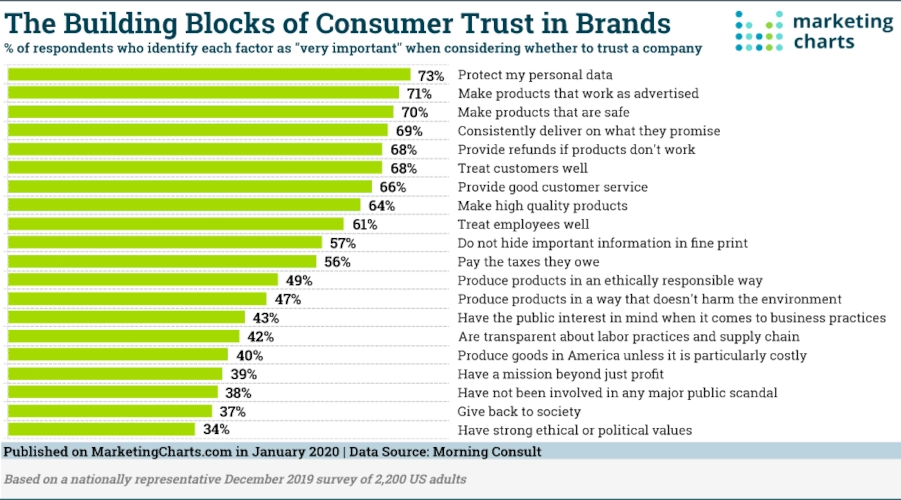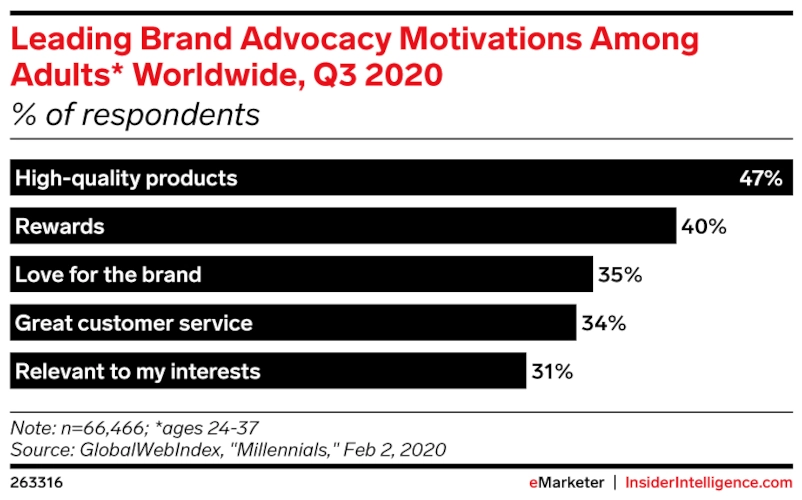Reading Time: 15 Minutes
Consumers talk. In every social media platform, dinner party, and networking event, someone mentions something they bought. These conversations fuel a chain reaction of purchases and word-of-mouth that ultimately make or break retail brands.
“According to a HubSpot study, 75% of consumers do not even consider advertisements as true. But 90% believe brand recommendations from friends and 70% trust consumer opinions… It is due to the fact that social proof works in marketing, and that today more than ever, traditional advertising is losing its sway over consumers.”
– Marketing Insider Group, 2021
Since these interactions occur regularly, many brands invest resources to find, join, and nurture them for long-term brand growth. This mindset sets the stage for brand advocacy programs in ecommerce.
Brand advocacy is positive word-of-mouth on behalf of your brand. It can occur organically between friends and family, events, social media campaigns, and referral programs.
A brand advocate, then, is anyone sharing your brand with the world. Many brand advocates act of their own accord because they love your products. Others may love your brand in secret but would be open to joining your program if you gave them a good reason to do so.
The key to any successful brand advocacy program is the authenticity and excitement of your advocates. True brand fans spread contagious enthusiasm throughout their communities.
The heart of any advocacy program is consumer trust. Earning that trust requires a brand to provide an excellent shopping experience.

From this customer-centric foundation, here are five things you need to launch a brand advocacy program of your own.
The easiest way to build relationships with your customers is to know who they are and initiate personal interactions. The more specifically you can define your ideal customer, the easier it will be to foster a genuine connection that results in word-of-mouth marketing for your brand.
Many brands fail to personalize their products and services for their ideal customer profile. Your customers need to be confident that their purchase is a worthwhile investment.
Quality products and services are a must for any brand advocacy program. To ensure that quality, many brands connect their product development teams with customer service. That way, customer feedback informs product fixes/upgrades and ensures consumer satisfaction.
Customers don’t usually abandon brands because of a problem with their purchase – they go elsewhere when they don’t feel supported by the brand. This is especially true of products that require a bit more training, understanding, or skill to use properly.
By equipping your customer support team with everything they need, they can empower buyers to troubleshoot issues quickly and get the most out of their purchase.
Some of the most powerful voices in brand advocacy come from within an organization. Happy employees are proactive in encouraging others to trust the brand they work for.
If your brand treats its own people well, many brand advocates will pop up organically and do great things to promote the company to new customers.
Once you’ve identified your top brand fans and feel that your business model supports an advocacy program, it’s important to decide what you want your program to do.
Brand advocates can help you meet any number of marketing objectives, including (but not limited to):
Your program goals determine how you will leverage your advocates to achieve success.
As with any marketing medium, your advocates should play a role in your overall marketing strategy. This means communicating with other team members and keeping your advocates informed of other initiatives that might be relevant to them.
Keep in mind that prospects don’t become customers overnight. The buyer’s journey dictates that people first become aware of your brand and need a certain number of touch points before they feel confident enough to buy.
Depending on what you’ve determined your program objectives to be, you can integrate your advocates anywhere in the buyer’s journey to feed the success of your greater marketing plan.
Powerful word-of-mouth marketing has many benefits and very few downsides. The trick is thinking about your audience on a personal level and what matters to them in a brand-consumer relationship.
In the short-term, brand advocacy initiatives motivate prospects to take next steps. Peer-to-peer recommendations carry far more weight than ads or company messaging.
Those who’ve never heard of your brand will see an advocate post on social media, become curious, and visit your website to learn more. Buyers who were on the fence feel more confident to complete their first purchase after advocates showcase your product.
This happens all the time on sites like Yelp and Google where customers leave positive, in-depth reviews for other buyers. It also occurs when advocates share a link to a product promotion page or an exclusive discount code.
Over time, the social proof generated from excited brand advocates will make it easier for your marketing and sales teams to acquire new customers. Because “word on the street” is consistently in your favor and spreading fast, more customers come to you instead of you going to them.
Additionally, brand advocates naturally build communities around your brand and the lifestyle that your products support. These communities increase customer loyalty and lifetime value.
In other words, strong brand advocacy increases your revenue while also lowering your costs.
A brand ambassador can be a type of brand advocate, but not all advocates are ambassadors.
Brand ambassadors act more like affiliates, in that they have a formal arrangement to promote your brand in exchange for commissions and/or free products.
Traditionally, you can’t be a true brand advocate and get paid on commission. But ambassadors who receive payment in product gifts are excellent examples of brand advocates.
Most brand ambassadors maintain 1,000 or more followers on one or more social networks. They possess an authoritative voice within an online community they created by publishing original content that appeals to those with similar interests and values.
In most cases, being a brand advocate is open to anyone who promotes your brand authentically and honestly. But the most common type of advocates include:
Employees that love working for their organization are among the best brand fans online today. They freely share special events, sales, or company news purely out of pride for where they work.
That’s why company culture is so important to both positive working conditions and marketing. Great cultures attract interest from those outside the organization.
Social media creators often promote their favorite brands and products without being asked to do so. This is especially true of micro and nano influencers who tend to be more connected to members of their audience than those with 100,000 or more followers.
When a creator gives your brand a shout-out, take a minute to connect, thank them for their kind words, and invite them into your advocacy program. These influencers can bring their own communities under your roof simply by being excited, loyal customers.
But many creators possess talents beyond mere shout-outs. Some produce incredible, studio-level content at affordable rates. Initiating relationships with influencers that genuinely love your brand opens up opportunities for more lucrative partnerships down the line.
Whether investors, brand partners, or industry peers with whom you have a strong relationship, your business partners can also do an amazing job of promoting your brand to outsiders. Wherever a professional relationship can lead to collaboration, don’t be afraid to invite them into your brand community.
The most common brand advocates will be your customers. And the more happy customers you have, the easier it will be to enlist their help as brand advocates.
Both brand advocates and influencers produce UGC and word-of-mouth marketing for your brand. But the way you collaborate with each group will vary.
Influencers are professional content creators, and as such, they can produce compelling lifestyle images, posts, and videos that are difficult to replicate. They also maintain a large following, and partnering with influencers unlocks the attention of thousands (sometimes millions) of consumers in a single campaign.
Brand advocates may not have the same level of influence or talent, but they are credible to those in their network. Having both partners on your team can certainly increase results across different niche audiences that meet your customer profile.
“So when we’re creating an advocacy program that is also a community, we have to think about, how does being part of this program help this advocate or ambassador make progress toward who they want to be in their lives?”
– Carrie Melissa Jones, Author of Building Brand Communities
A true brand advocacy program doesn’t pay advocates with cash or commissions, but instead gives them free products and exclusive perks.

Depending on the type of people in your program, anything from handwritten “thank you” notes to early access to new products can make advocates thrilled to be a part of your campaigns.
The key is that if you are going to ask something of them, you must be willing to offer them something in return. And what you offer should be compelling – something that your advocates would truly appreciate.
Brand advocates are a type of partnership, as are celebrities, athletes, ambassadors, or influencers within your creator program. Each partnership requires a different approach when planning and executing your campaigns.
Using a reliable creator management platform allows you to segment your different partnerships clearly so that each partner gets the attention and support they need to succeed.
Every advocate is an individual that merits your attention. Keeping details organized among your many marketing relationships can be challenging without the right software solution.
When including your advocates in a social media campaign, your process ensures that no advocate or task falls through the cracks. A creator management platform automates time-consuming tasks to help your team personalize the campaign experience for each brand partner.
By stating your marketing objectives at the beginning, you can establish key performance indicators (KPIs) that show you how well your campaign is helping you reach those goals. To truly understand the ROI of your brand advocacy program, you’ll need a software solution that tracks performance by accurately attributing web visits, post engagements, and conversions to the right partner.
Marketing is changing fast in 2021. From the recent Facebook outage to iOS 14 security updates, marketers are struggling to maintain their traditional approach to finding new customers.
But with change and disruption come new opportunities. Your best brand fans are at your fingertips, ready to spread the word on your behalf. Consolidating those positive voices into one brand advocacy program can be just the thing your ecommerce business needs to achieve rapid growth.
Are you ready to stake your claim in the creator economy? Discover more helpful tips and resources from the experts at GRIN: Creator Management Learning Center
Our team keeps a finger on the pulse, so you’re always working with the latest information.